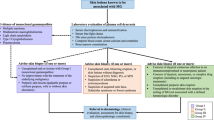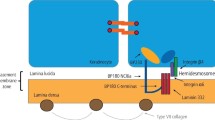Key Points
-
Characteristic oro-facial signs are prominent features of Kawasaki disease
-
The patient may first seek treatment by a dental practitioner
-
Morbidity and mortality can be reduced by early recognition and appropriate treatment
-
Antibiotic cover is needed in patients with heart valve damage caused by Kawasaki disease
-
Kawasaki disease may re-occur.
Abstract
Kawasaki disease (mucocutaneous lymph node syndrome) is a disease of unknown aetiology characterised by vasculitis which may affect the coronary arteries. Young children are most commonly affected although the disease has been described in adults. We report a case of recurrent Kawasaki disease which presented to an oral medicine clinic, where early recognition prompted appropriate management.
Similar content being viewed by others
Main
Kawasaki disease (mucocutaneous lymph node syndrome) was first described by Dr Tomisaku Kawasaki in 1967.1 Since then, more than 100,000 cases have been reported worldwide, the majority occuring in Japan.2 The disease predominantly affects young children and it is now the commonest cause of acquired heart disease in children in developed countries.3 The diagnosis is based on the presence of at least five of the following six clinical features: 1) persistent fever, 2) polymorphous rash, 3) characteristic changes in the extremities (erythema of the hands and feet followed by desquamation of the fingers and toes), 4) bilateral conjunctivitis, 5) cervical lympha- denopathy, 6) oropharyngeal changes including 'strawberry' tongue (prominent lingual papillae); dry, erythematous or cracked lips, and erythema of the oropharyngeal mucosa.2 The oral changes are a prominent feature of this serious disease and it is quite possible that some cases will present to dentists or dental departments in the first instance. Despite this, there appears to be little awareness of the condition in the dental community and the condition has received little attention in the dental literature.4 Since early diagnosis and treatment is important, the condition should be considered in children presenting with any of the oral features of the disease.
Case study
A 6-year-old boy of mixed Afro-Caribbean and Caucasian heritage presented to the oral medicine clinic with a 3-day history of lethargy, mild pyrexia, and a sore tongue. His past medical history was unremarkable apart from an episode of Kawasaki disease 15 months previously, which had been treated with intravenous immunoglobulin and oral aspirin. There had been no cardiac sequelae. At presentation in the oral medicine clinic, systemic and oral examination was unremarkable apart from the presence of a brightly erythematous tongue with prominent lingual papillae (fig. 1). This 'strawberry' tongue appearance produced a differential diagnosis including recurrent Kawasaki disease and scarlet fever. There was no history of sore throat or evidence of tonsillar exudate and scarlet fever was thought to be unlikely. Arrangements were made for the child to be reviewed by his paediatrician. Within 2 days he had developed conjunctivitis, generalised lymphadenopathy and desquamation of his finger tips. A clinical diagnosis of recurrent Kawasaki disease was made and treatment with a single dose of 2 g/kg of intravenous immunoglobulin and regular daily aspirin was initiated. Streptococcal serology was negative and no other explanation of his signs and symptoms became apparent. Examination of his cardiovascular system including echocardiography revealed no abnormalities. The patient was discharged 3 days after admission and within a month the original signs and symptoms had resolved. Further follow-up including echocardiography has been uneventful.
Discussion
Kawasaki disease is predominantly a disease of childhood although cases have been reported in adults.5 Around 80% of cases occur in children under 5 years of age.2 It occurs more often in boys than girls with a male/female ratio of about 1.5:1. Since first being described in the Japanese population, where it retains its highest incidence, cases have been reported worldwide in children of all racial backgrounds. In Britain, Kawasaki disease remains uncommon. The reported incidence in the UK is 3 to 4 cases per 100,000 children aged under 5 years,6 about one thirtieth of that in Japan.7 It is possible that cases are missed, not least because many common childhood infections have similar clinical features.3 The differential diagnosis includes Streptococcal infection (such as scarlet fever), Staphylococcal infection (such as scalded skin syndrome), erythema multiforme, measles, and less commonly leptospirosis, juvenile rheumatoid arthritis and drug reactions. Making the diagnosis of Kawasaki disease frequently involves excluding these other diseases while remaining alert to the possibility of Kawasaki disease, the features of which may appear sequentially rather than simultaneously. Alertness is also required for incomplete cases which lack all of the classical signs. Some cases also have atypical clinical presentations which are only diagnosed after the characteristic coronary artery changes have been found on echocardiography or at necropsy.8 A high degree of suspicion is required in patients who have a previous history of Kawasaki disease and present with clinical signs consistent with recurrence. In the case reported here, the presenting feature of the 'strawberry' tongue led to the alternative diagnosis of scarlet fever associated with Streptococcal tonsillitis. In both conditions fever, malaise, cervical lymphadenopathy and an erythematous skin rash adds confusion. However in Kawasaki disease, there is also a failure to respond to antibiotics, conjunctivitis, no tonsillar exudate and, as found in this case, no rise in anti-streptococcal titres. Throat swabs are also usually negative in Kawasaki disease, although carriage of group A Streptococcus does not exclude the diagnosis.2
The primary pathological process in Kawasaki disease is a widespread vasculitis.7 In the acute phase of the disease, the pericardium, myocardium, endocardium and coronary arteries may all be affected. Coronary artery aneurysms occur in around 20–30% of untreated cases.7 Up to 4% of cases of untreated Kawasaki disease will progress to sudden death during the acute phase of the illness as a result of aneurysmal thrombus formation, myocardial infarction or dysrhythmia.6 While many aneurysms appear to resolve spontaneously, long-term morbidity can result from scarring of cardiac tissue. In about 1% of cases the heart valves are affected,9 in which case antibiotic prophylaxis against infective endocarditis will be necessary prior to relevant dental procedures in the future.
The aetiology of Kawasaki disease remains obscure. Epidemiological evidence suggests a microbial agent as the likely cause, however no causative organism has been identified to date.3 A recent hypothesis is that the disease is caused by a bacterial superantigen toxin, similar to that responsible for the Staphylococcal and Streptococcal toxic shock syndrome.3 Regardless of aetiology, early treatment with a single dose of intravenous immunoglobulin (2 g/kg) has been shown to significantly reduce the incidence and severity of aneurysm formation as well as providing symptomatic relief for the acute illness.10 Immunoglobulin appears to be most beneficial if given as early as possible after diagnosis.2 Low dose aspirin is also used for its anti-inflammatory and anti-thrombotic effects although its efficacy remains unproven. Paracetamol can also be used as an anti-pyretic.
Recurrence of the disease has been previously noted with reported rates varying between 0.8% in the United States to 3% in Japan.11,12 The proportion of patients suffering a recurrence increases with age, while the majority of recurrences occur within 2 years of the initial attack.12 In rare cases (0.2%), patients can suffer multiple recurrences.12 Interestingly, the only factor so far identified which predisposes to recurrence is previous treatment with immunoglobulin,13 a feature of the case described.
Kawasaki disease has prominent oral and facial manifestations, which may lead to presentation to dental practitioners. In view of the significant morbidity and mortality associated with untreated disease, early diagnosis and treatment are important in the management of this condition. Dentists should remain alert to features of the acute disease, and in patients with a history of Kawasaki disease, be aware of the possibility of recurrence and of heart valve defects requiring antibiotic prophylaxis prior to relevant dental treatment.
References
Kawasaki T . Acute febrile mucocutaneous lymph node syndrome with lymphoid involvement with specific desquamation of the fingers and toes in children. Jpn J Allergy 1967; 16: 178–222.
Dajani A S, Taubert K A, Gerber M A et al. Diagnosis and therapy of Kawasaki disease in children. Circulation 1993; 87: 1776–1780.
Curtis N . Kawasaki disease. BMJ 1997; 315: 322–323.
Ogden G R, Kerr M . Mucocutaneous lymph node syndrome (Kawasaki disease). Oral Surg Oral Med Oral Pathol 1989; 67: 569–572.
Thompson A C, Lamey P J . Kawasaki syndrome in an adult. J Laryngol Otol 1990; 104: 569–572.
Dhillon R, Newton L, Rudd P T, Hall S M . Management of Kawasaki disease in the British Isles. Arch Dis Child 1993; 69: 631–636.
Kato H, Akagi T, Sugimura T et al. Kawasaki disease. Coron Artery Dis 1995; 6: 194–206.
Rowley A H, Gonzalez C F, Gidding S S, Duffy C E, Shulman S T . Incomplete Kawasaki disease with coronary artery involvement. J Paediatr 1987; 110: 409–413.
Akagi T, Kato H, Inoue O, Sato N, Imamura K . Valvular heart disease in Kawasaki syndrome: Incidence and natural history. Am Heart J 1990; 120: 366–372.
Newburger J W . Treatment of Kawasaki disease. Lancet 1996; 347: 1128.
Bell D M, Morens D M, Holman R C, Hurwitz E S, Hunter M K . Kawasaki syndrome in the United States. Am J Dis Child 1983; 137: 211–214.
Yanagawa H, Nakamura Y, Yashiro M, Hirose K . Results of 12 nationwide surveys of Kawasaki disease. In Kato H (ed) Kawasaki disease. pp 3–14. Amsterdam: Elsevier Science, 1995.
Nakamura Y, Yanagawa H . A case-control study of recurrent Kawasaki disease using the database of the nationwide surveys in Japan. Eur J Pediatr 1996; 155: 303–307.
Author information
Authors and Affiliations
Additional information
Refereed paper
Rights and permissions
About this article
Cite this article
Pemberton, M., Doughty, I., Middlehurst, R. et al. Recurrent Kawasaki disease. Br Dent J 186, 270–271 (1999). https://doi.org/10.1038/sj.bdj.4800085
Received:
Accepted:
Published:
Issue Date:
DOI: https://doi.org/10.1038/sj.bdj.4800085
This article is cited by
-
Kawasaki disease recurrence in the COVID-19 era: a systematic review of the literature
Italian Journal of Pediatrics (2021)
-
Letters
British Dental Journal (1999)




